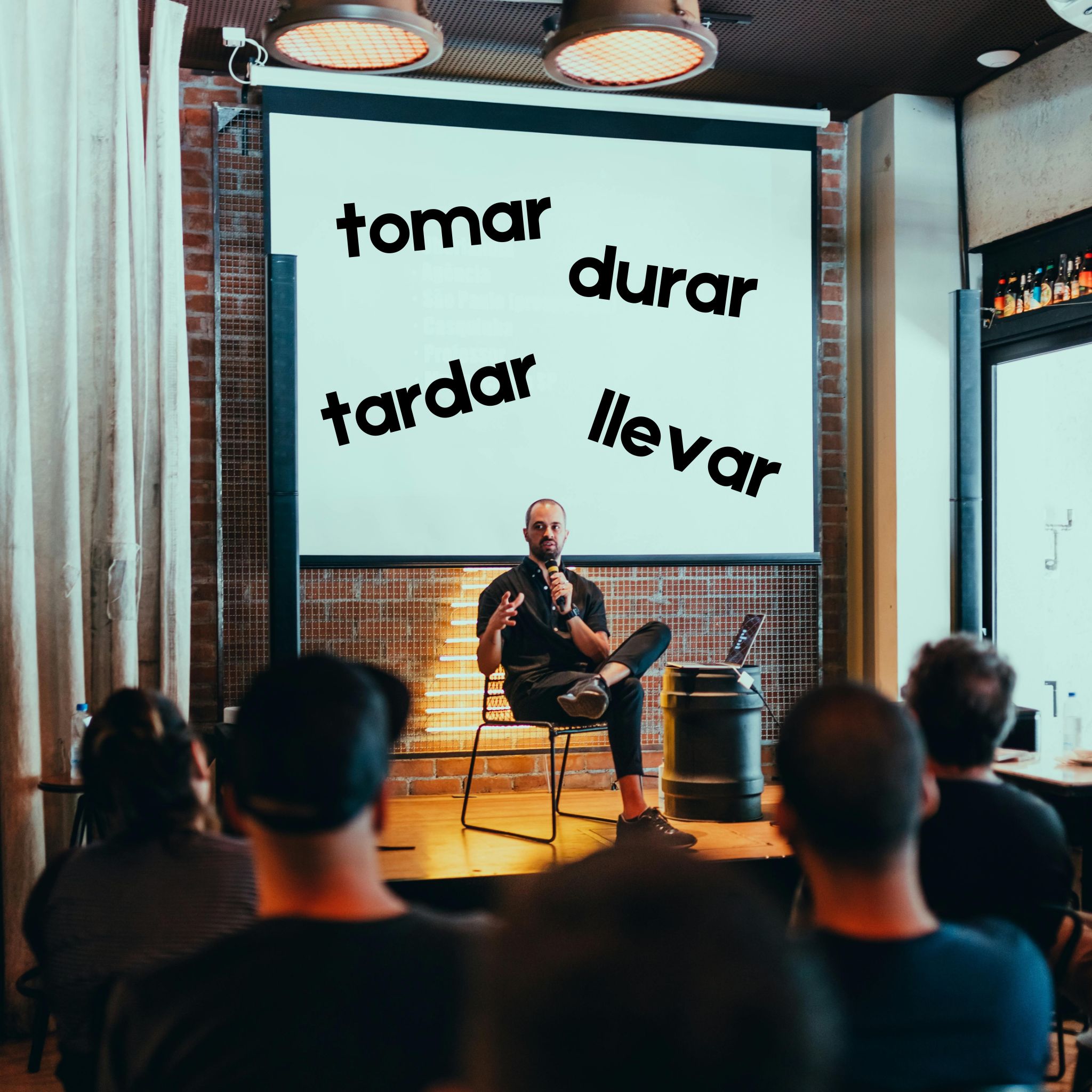Tomar, Durar, Tardar, Llevar: Spanish verbs to talk about lengths of time

Get our free email course, Shortcut to Conversational.
Have conversations faster, understand people when they speak fast, and other tested tips to learn faster.
More infoWhen we want to explain how long something takes, or how long you’ve been doing something, we have several different ways of expressing the concept of how long in Spanish.
In today’s post we’ll introduce the key verbs and expressions we use to talk about lengths of time and durations in Spanish. By the end of the post, you’ll know how and when to use tomar vs durar vs tardar vs llevar.
Por
Before we begin with our verbs for talking about duration in Spanish, we should mention por. This is actually the most common way to express duration, and it’s usually translated into English as for. In general, por is usually followed by a frequency or period of time.
We have a full post on using for in Spanish in our comparison post on por vs para, so for now we’ll just leave you with a few examples before we move on to our verbs.
- Yo juego fútbol tres veces por semana. – I play soccer three times per week.
- Estuve enfermo por tres días. – I was sick for three days.
- Busqué mis aretes por dos horas y no los encontré. – I looked for my earrings for two hours and couldn’t find them.
Cuánto
The other important word we need to mention before talking about lengths of time in Spanish is the question word cuánto, usually translated as how much in Spanish. Just keep in mind that the question word always has an accent, as opposed to the unaccented cuanto.
Cuánto has four forms to match the gender and number of whatever is being asked about, but it remains cuánto when we just refer to time: el tiempo. You’ll see cuánto in several of our example sentences in the following sections; for full lessons, see our dedicated posts on cuánto and cuanto.
Now that we’ve mentioned por and cuánto, we’re ready to cover the four verbs we use to describe lengths of time and to ask how long in Spanish: tomar, durar, tardar, and llevar.
Tomar
Tomar in Spanish means to take. There are actually many meanings of tomar, but in the context of time, it’s used to talk about the time it takes to complete an activity.
- ¿Cuánto toma cruzar el puente? / Toma 20 minutos. – How long does it take to cross the bridge? / It takes 20 minutes.
- No sé cuánto tome el taxi en llegar. – I don’t know how long the cab will take to arrive.
- La realización del proyecto tomará tres meses. – The project will take three months to complete.
Tomar can also be used with indirect object pronouns to signal that something takes someone or something time.
- Me toma diez minutos vestirme para salir. – It takes me ten minutes to get dressed to go out.
- Le tomó un tiempo recuperarse de la caída, pero ahora está mejor. – It took her a while to recover from the fall, but she’s better now.
- ¿Cuánto te toma hacer un pastel? – How long does it take you to bake a cake?
Durar
Durar in Spanish means to last, relating to an elapsed period of time. It’s used to talk about the duration of an event, the lifespan of an object, or even how long a feeling might persist.
durar + length of time
- La conferencia duró tres horas. – The conference lasted three hours.
- La tormenta no durará para siempre. – The storm won’t last forever.
- Estas medias no duraron nada, eran de mala calidad. – These stockings didn’t last at all, they were of poor quality.
- ¿Cuánto duró la fiesta? – How long did the party last?
Tardar
Tardar in Spanish doesn’t have an exact English translation. It can be translated as to take [time] or to spend [time], referring to how long an action takes. There are a couple of possible constructions when we use tardar, each with their own nuance in meaning, so we’ll cover each of them here.
tardar + period of time + en + infinitive
How do we use tardar in a sentence? We conjugate tardar and then follow it with a period of time, then we link it with en to the infinitive of the action verb that takes time. In this way, we use tardar to say that some action takes that amount of time, or to say that the person spends that amount of time doing the action.
- Tardé dos años en escribir mi tesis. – It took me two years to write my dissertation.
- Luis tardó una hora en responder a mi mensaje. – Luis took an hour to reply to my message.
- ¿Cuántos días tardas en leer el libro? – How many days does it take you to read the book?
tardar + en + infinitive
If we don’t specify a particular time frame, tardar conveys the sense that something or someone is taking too long. In these instances, it can also be used reflexively to indicate who is taking too long.
- Ana tardó en llegar y nos fuimos sin ella. – Ana took too long to arrive and we left without her.
- Necesito salir un momento, te prometo que no me tardo. – I need to leave for a moment, I promise I won’t be late.
- Si tardas, perderemos el vuelo. Date prisa. – If you’re late, we’ll miss our flight. Hurry up.
- No te tardes, ya casi vienen por nosotros. – Don’t take long, they’re almost here for us.
Llevar
The Spanish verb llevar can be used to describe how long something has been happening, starting from a point in the past and continuing up to the present moment. There are several combinations with this verb, so let’s take a look at each one.
llevar + time period + gerund / llevar + gerund + time period
Here, llevar acts as an auxiliary verb along with the gerund. This combination highlights how long an action has been going on. The meaning is the same whether we place the time period before or after the gerund.
- Jaime lleva tres horas viendo la televisión. / Jaime lleva viendo la televisión tres horas. – Jaime has been watching TV for three hours.
- Llevamos dos meses viviendo en México. / Llevamos viviendo en México dos meses. – We have been living in Mexico for two months.
- Llevo esperándote más de una hora. / Llevo más de una hora esperándote. – I’ve been waiting for you for more than an hour.
- ¿Cuántas horas llevas jugando ese juego? – How many hours have you been playing this game?
llevar + gerund + desde + moment in time
When we want to highlight a specific point in time when the action began, we use the same llevar + gerund formula along with desde + moment of time. In this sense, desde means since in Spanish, though it sometimes also translates as from.
- Andrea lleva estudiando desde la mañana. – Andrea has been studying since morning.
- Mis hermanas llevan viviendo ahí desde el año pasado. – My sisters have been living there since last year.
- Llevo pensando en eso desde ayer. – I’ve been thinking about this since yesterday.
llevar + period of time + place / llevar + place + period of time
Here we use llevar directly with a period of time and a place, without any additional verb. We use llevar in this context to describe how long someone or somebody has been in a place. When we talk about a specific place, the preposition en is used.
- Llevo tres días aquí. / Llevo aquí tres días. – I’ve been here for three days.
- Ella lleva cuatro años en Francia. / Ella lleva en Francia cuatro años. – She has been in France for four years
llevar + place + desde + moment in time
To specify the moment in the past when an ongoing action began in a place, we can include the preposition desde to mean since for a specific moment, or for for a vaguer point of time in the past.
- Tus cosas llevan aquí desde ayer. – Your stuff has been here since yesterday.
- Mi papá lleva en Portugal desde hace meses. – My dad has been in Portugal for months.
Similarly, we can create negative sentences with desde by adding sin + infintive.
- Mis amigas llevan desde el viernes sin llamarme. / Mis amigas llevan sin llamarme desde el viernes. – My friends haven’t called me since Friday.
- Llevo desde ayer sin estudiar. / Llevo sin estudiar desde ayer. – I haven’t studied since yesterday.
llevar + period of time + sin + infinitive
This is the construction we use to describe how long it’s been since a certain activity last took place. We’re really emphasizing the absence of a specific action here.
- Tú llevas ocho meses sin visitar a tus abuelos. – You haven’t visited your grandparents for eight months.
- Daniel y Pedro llevan diez días sin hablarse. – Daniel and Pedro haven’t talked for ten days.
Llevar + period of time + adjective / past participle
We use this construction to describe the state of people or objects over a certain period of time. Llevar acts as an auxiliary verb if the descriptive word is a past participle, but it works the same way with other adjectives as well.
- Llevo una semana enfermo. / Llevo enfermo una semana. – I’ve been sick for a week.
- Tu ropa lleva días colgada al sol. / Tu ropa lleva colgada al sol días. – Your clothes have been hanging in the sun for days.
- El bebé lleva dos horas horas dormido. / El bebé lleva dormido dos horas. – The baby has been sleeping for two hours.
- Llevas toda la semana triste. / Llevas triste toda la semana. – You‘ve been sad all week.
Conclusion: Describing durations in Spanish
Great job! Now that you’ve mastered the nuances of expressing how long in Spanish, let’s do a quick recap.
In this post, we explored key verbs used to discuss the length of time in Spanish: tomar, durar, tardar, and llevar.
Tomar and tardar both emphasize the time an action or event takes to be completed.
Durar expresses the amount of time over which something takes place, or the longevity of objects.
Lastly, llevar provides a window into ongoing actions or states, indicating how long something has been happening or how long someone has been in a particular state. It can act as an auxiliary verb to other action verbs to say how long their actions have been happening.
By understanding these verbs and their nuances, you’re equipped to navigate conversations about time with confidence and clarity in Spanish. Now that you’ve got these down, why not check our post on telling time in Spanish for yet another angle on how to talk about time and durations in Spanish!


